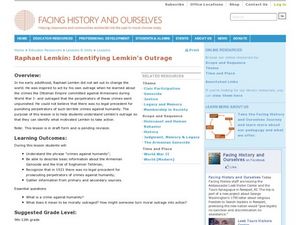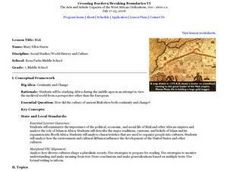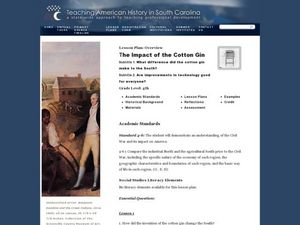Curated OER
Underground Railroad
Fourth graders read about Harriet Tubman and develop vocabulary lists. In this Underground Railroad lesson, 4th graders find similarities and differences in primary and secondary sources, create a timeline and recognize important people...
Curated OER
"A MLA Style of Life"
Learners effectively research using the internet, encylopedias, magazines and newspapers. They desegregate into needed and un-needed information based on their research findings. Pupils recognize and appropriately site sources using a...
Curated OER
Southeastern Native Americans' Lifestyles
Young scholars complete activities to learn about Southeastern Native Americans. In this lifestyles lesson, students watch a PowerPoint about Southeastern Native Americans, view artifacts from the region and discuss the objects with a...
Curated OER
The Rise of Hitler
Eleventh graders investigate how Hitler was able to harness Germany. In this World War II lesson, 11th graders conduct primary and secondary source research to determine how Hitler used the Great Depression, charisma, scapegoats, and the...
Curated OER
World War I: War in a Democratic Society
Students research opposition and support for World War I from a number of perspectives. They analyze a number of primary and secondary sources, while considering what (if anything) makes a war just and write a letter expressing his/her...
Facing History and Ourselves
Raphael Lemkin: Identifying Lemkin's Outrage
Students examine World War I war crimes. In this world history lesson plan, students use primary and secondary sources to research Armenian genocide and the trial of Soghomon Tehlirin.
Curated OER
Japan: Traditions and Culture
Fourth graders explore Japanese customs and history. They create their own works that reflect these traditions. They identify and use primary and secondary sources to learn and communicate about the past.
Curated OER
How Has Transportation Changed Since the 1899 Harriman Alaska Expedition?
Students recognize modes of transportation. They research historical data from a variety of primary and secondary sources including the Harriman expedition journals, related web sites, and photographs from the expedition. Students...
Curated OER
Evacuation: The Japanese Americans in World War II
Students examine Japanese internment camps of World War II. In this World War II instructional activity, students use primary and secondary sources to research the evacuation process and life within the internment camps. Students discuss...
Curated OER
Unchained Memories
Eleventh graders consider what life was like for American slaves. In this primary source analysis instructional activity, 11th graders read slave narratives from Unchained Memories and then participate in a discussion about the...
Curated OER
Adventures with Lewis and Clark
Students interpret historical evidence presented in primary and secondary resources. In this Lewis and Clark lesson, students conduct research about the expedition and present their findings to their classmates.
Curated OER
Teaching With Documents Lesson Plan: Images of the American Revolution
Students interpret historical evidence presented in primary and secondary resources. In this American Revolution lesson, students examine international involvement in the war as well as major events of the war.
Curated OER
Carter’s Approach to Facing the Energy Crisis
High schoolers examine President Carter's stance on the energy crisis of the 1970s. In this energy crisis instructional activity, students analyze primary sources that feature the crisis during Carter's term. High schoolers script and...
Curated OER
Mali
Seventh graders begin the lesson by reading primary sources about the country of Mali. Using maps drawn in the past, they discuss what they can gather about the country from the map and how it has changed over time. They use a graphic...
Curated OER
Native American Gender Roles in Maryland: A Second Look
In this primary source analysis worksheet, students examine Native American history to complete the graphic organizer about gender roles in Native American societies.
Curated OER
Child Labor Laws in the United States and the State of Nebraska
Students examine child labor laws. In this social justice lesson plan, students compare and contrast child labor laws of the United States and the state of Nebraska. Students research primary sources and complete the included analysis...
Texas State Energy Conservation Office
Unit 2 - Section 2 - Fuels for Everything
In this alternative energy worksheet, 6th graders read and study the varying types of fuel. Students read examples and ways that alternative fuel can be used.
Curated OER
Language Arts: Gathering the Appropriate Information
Students are able to use the library and/or computer lab to research reliable information sources supporting arguments being put forward in the position paper. They are able to find examples of mission statements from various...
Curated OER
The Impact of the Cotton Gin
Fourth graders study Eli Whitney and the cotton gin. In this lesson plan on the cotton gin, 4th graders use primary and secondary sources to gather information about Eli Whitney, the cotton gin that he invented and how it changed the south.
Curated OER
In The Words of Abraham Lincoln...
Young scholars explore the words of Abraham Lincoln. In this Abraham Lincoln activity, students analyze segments of "The Gettysburg Address," his annual address to Congress in 1862, and his letter to Mrs. Bixby. Young scholars conduct...
James Madison Memorial Fellowship Foundation
Those "Other Rights:" The Constitution and Slavery
Did the United States Constitution uphold the institution of slavery, or did it help to destroy it? Young historians study Article 4, Section 2, Clause 3 of the Constitution and evaluate the rights of slaveowners as they compared to or...
Roy Rosenzweig Center for History and New Media
American Indians and their Environment
People could take a page in ingenuity and survival from the Powhatans. Deer skins became clothes, and the members of the Native American group farmed the rich Virginia soil and hunted in its forests for food. Using images of artifacts...
Syracuse University
Ancient World Writing System
Most twenty-first century pupils don't know how to interpret cuneiform. Examining images of cuneiform and papyrus writing and using a chart and Venn diagram, young historians extrapolate what life may have been like for people who lived...
Syracuse University
World War I
World War I was known for its gruesome battlefields and horrific injuries. Using photographs from a battlefield surgeon's scrapbook, scholars see first-hand what life was like in the trenches. After creating a timeline of the war using...

























